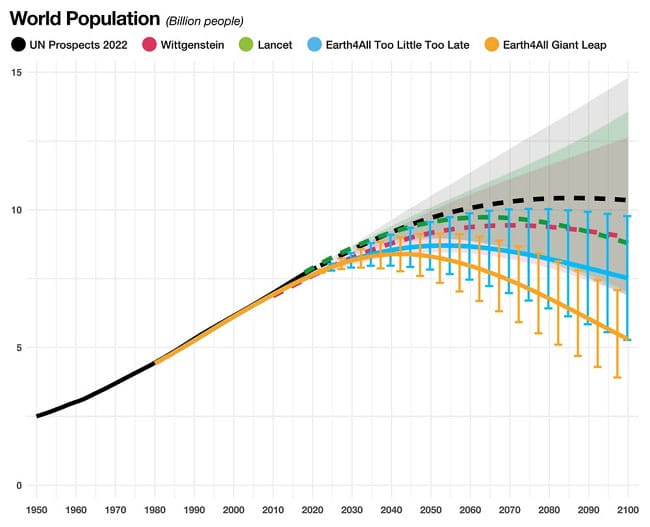
Comparing five population scenarios to 2100 (United Nations, Wittgenstein,
Lancet, Earth4All – Too Little Too Late, Earth4All – Giant Leap).
In November 2022, the world crossed a milestone of 8 billion people but new analysis suggests the global population could peak just below 9 billion people in 2050 then start falling.
The new projection is significantly lower than several prominent population estimates, including those of the United Nations. The researchers go further to say that if the world takes a “Giant Leap” in investment in economic development, education and health then global population could peak at 8.5 billion people by the middle of the century.
The new projections by researchers from the Earth4All initiative for the Global Challenges Foundation is published as a working paper People and Planet: 21st Century Sustainable Population Scenarios and Possible Living Standards Within Planetary Boundaries.
The team used a new system dynamics model, Earth4All, to explore two scenarios this century. In the first scenario – Too Little Too Late – the world continues to develop economically in a similar way to the last 50 years. Many of the very poorest countries break free from extreme poverty. In this scenario the researchers estimate global population could peak at 8.6 in 2050 before declining to 7 billion in 2100.
In the second scenario, called the Giant Leap, researchers estimate that population peaks at 8,5 billion people by around 2040 and declines to around 6 billion people by the end of the century. This is achieved through unprecedented investment in poverty alleviation – particularly investment in education and health – along with extraordinary policy turnarounds on food and energy security, inequality and gender equity. In this scenario extreme poverty is eliminated in a generation (by 2060) with a marked impact on global population trends.
The authors argue that other prominent population projections often underplay the importance of rapid economic development.
“We know rapid economic development in low-income countries has a huge impact on fertility rates. Fertility rates fall as girls get access to education and women are economically empowered and have access to better healthcare,” said Per Espen Stoknes, Earth4All project lead and director of the Centre for Sustainability at Norwegian Business School.
“Few prominent models simulate population growth, economic development and their connections simultaneously,” comments Beniamino Callegari, an Associate Professor from Kristiania and member of the Earth4All modelling team.
The analysis uses ten world regions such as Sub-Saharan Africa, China and the United States. Currently, population growth is highest in some nations in Africa, such as Angola, Niger, the Democratic Republic of Congo and Nigeria, and Asia, for example Afghanistan.
“If we assume these countries adopt successful policies for economic development then we can expect population to peak sooner rather than later,” continues Callegari.
The team also analyzed the connection between population and exceeding planetary boundaries, which is linked to the carrying capacity of Earth. Contrary to public popular myths, the team found that population size is not the prime driver of exceeding planetary boundaries such as climate change. Rather, it is extremely high material footprint levels among the world’s richest 10% that is destabilizing the planet.
“Humanity’s main problem is luxury carbon and biosphere consumption, not population. The places where population is rising fastest have extremely small environmental footprints per person compared with the places that reached peak population many decades ago.” said Jorgen Randers, one of leading modelers for Earth4All and co-author of The Limits to Growth.
According to the team’s demographic projections, the entire population could achieve living conditions exceeding the United Nations minimum level without significant changes in current developmental trends, provided an equal distribution of resources.
The researchers also concluded that at current population levels it is possible for everyone to escape extreme poverty and pass a minimum threshold for a dignified life with access to food, shelter, energy and other resources. However, this requires a (much more) equal distribution of resources.
“A good life for all is only possible if the extreme resource use of the wealthy elite is reduced,” concludes Randers.



“Rather, it is extremely high material footprint levels among the world’s richest 10% that is destabilizing the planet.”
The problem is the resources that the 10% are consuming, they are not renewable. So reducing the 10%’s consumption by itself is not a long term solution. Humanity as a whole needs to recognise that we are a part of nature NOT apart from nature so ideally anything that we do, especially collectively, must be in tune with nature not against it. It must nurture nature and as a consequence we will be nurturing ourselves for our long term survival. I recommend looking up the website of Biomimicry. for more thinking along these lines.